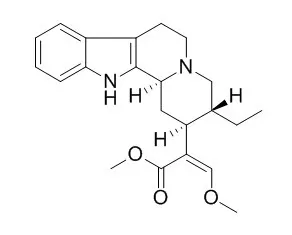| In vitro: |
| Planta Medica, 2014 , 66 (6) :531-6. | | Leishmanicidal, Antiplasmodial and Cytotoxic Activity of Indole Alkaloids from Corynanthe pachyceras.[Reference: WebLink] | Five indole alkaloids, corynantheidine, corynantheine, Dihydrocorynantheine, -yohimbine and corynanthine were isolated from bark of Corynanthe pachyceras K. Schum. (Rubiaceae).
METHODS AND RESULTS:
The structures were established by spectroscopic methods, inlcuding previously unreported assignment of all 1 HNMR resonances by COSY and NOESY experiments. These and related alkaloids showed pronounced activity against Leishmania major promastigotes (IC50 at the micromolar level) but no significant in vitro antiplasmodial activity (against chloroquinesensitive Plasmodium falciparum).
CONCLUSIONS:
Cytotoxicity assessed with drug sensitive KB-3-1 and multidrug-resistant KB-V1 cell lines was low; the alkaloids are apparently not substrates for the Pglycoprotein (P-170) efflux pump. | | J Nat Prod. 2011 Jan 28;74(1):12-5. | | Macrophyllionium and macrophyllines A and B, oxindole alkaloids from Uncaria macrophylla.[Pubmed: 21070010 ] |
METHODS AND RESULTS:
An unusual oxindole alkaloid inner salt, macrophyllionium (1), and a pair of new tetracyclic oxindole alkaloids, macrophyllines A (2) and B (3), together with six known alkaloids, were isolated from the aerial parts of Uncaria macrophylla.
CONCLUSIONS:
Corynantheidine (8) exhibited moderate cytotoxicity against HL-60 and SW480 cells with IC(50) values of 13.96 and 23.28 μM, respectively. Dihydrocorynantheine (9) exhibited significant vasodilating activity against phenylephrine-induced contraction in rat thoracic aorta rings (IC(50) = 6.73 μg/mL). In addition, compounds 2, 6, and 9 showed weak inhibitory action on KCl-induced contraction. |
|






 Cell. 2018 Jan 11;172(1-2):249-261.e12. doi: 10.1016/j.cell.2017.12.019.IF=36.216(2019)
Cell. 2018 Jan 11;172(1-2):249-261.e12. doi: 10.1016/j.cell.2017.12.019.IF=36.216(2019) Cell Metab. 2020 Mar 3;31(3):534-548.e5. doi: 10.1016/j.cmet.2020.01.002.IF=22.415(2019)
Cell Metab. 2020 Mar 3;31(3):534-548.e5. doi: 10.1016/j.cmet.2020.01.002.IF=22.415(2019) Mol Cell. 2017 Nov 16;68(4):673-685.e6. doi: 10.1016/j.molcel.2017.10.022.IF=14.548(2019)
Mol Cell. 2017 Nov 16;68(4):673-685.e6. doi: 10.1016/j.molcel.2017.10.022.IF=14.548(2019)